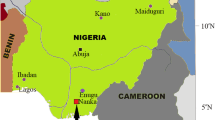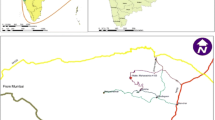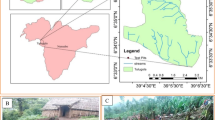Abstract
A potential head ward retreat landslide area was identified in Munnar, a hill station in Western Ghats of Kerala, India. This imminent landslide was suspected to be formed in three different stages viz., evolution of plateau region, upliftment of the plateau region and the consequent slope modification which ultimately facilitated landslide occurrence. Geophysical study through vertical electrical sounding reveals that more than 11 m thick soil is still left in an overhanging position in the crown portion of the landslide and the thickness continues to the top of that ridge. In the event of high rainfall, the land can fail as there is no toe support, and the slope angle is >40º. This area is adjacent to a college building and in the event of any further landslide, the consequence will be high. Slope stability analysis using one-dimensional infinite slope stability model reveals that the entire area occupied by the college and the adjacent areas are unstable even in dry conditions. Rainfall threshold analysis shows that the landslide occurred due to very high amount of a 5-day antecedent rainfall rather than a daily rainfall during the monsoon. All these point towards a pressing requirement of landslide management practices in this area. This study also attempts to suggest a few management practices to minimize the effect of landslides.
Similar content being viewed by others
References
Abraham, P.B. and Shaji, E. (2013) Landslide hazard zonation in and around Thodupuzha-Idukki-Munnar road, Idukki district, Kerala: A geospatial approach. Jour. Geol. Soc. India, v.82(6), pp.649–656.
Aleotti, P. (2004) A warning system for rainfall-induced shallow failures. Engg. Geol., v.73, pp.247–265.
Anbazhagan, S., Sajinkumar, K.S. (2011) Geoinformatics in terrain analysis and landslide susceptibility mapping in parts of Western Ghats, India. In: Anbazhagan S, Subramaniam SK, Yang X (Eds), Geoinformatics in Applied Geomorphology, CRC Press, pp.291–315
Anjorin, M.P. and Olorunfemi, M.O. (2012) A Short Note on Comparative Study of Schlumberger and Half SchlumbergerArrays in Vertical Electrical Sounding in a Basement Complex Terrain of Southwest Nigeria. The Pacific Jour. Sci. Tech., v.12(2), pp.528–533
Baiju, C.K., Ajaykumar B., Gopinath, G., Chandran, M.S.S. and Ramkumar, T. (2015) GIS based morphometric analysis of the Kochara sub-watersheds of Greater Periyar Plateau (GPP) of South Western Ghats, India. Internat. Jour. Advanced Remote Sensing and GIS, v.4(1), pp.895–910.
Caine, N. (1980) The rainfall intensity duration control of shallow landslides and debris flows. Geografiska Annaler, v.62, pp.23–27.
Cancelli, A. and Nova, R. (1985) Landslides in soil debris cover triggered by rainstorms in Valtellina (central Alps, Italy). In: Sassa, K. (Ed.), Proc. of 4th Intl. Conf. on Landslides, Tokyo. The Japanese landslide Society, Tokyo, pp.267–272
Chattopadhyay, S. and Sureshkumar, S. (2013) Glimpses of Kerala through Maps. Centre for Earth Science Studies, Trivandrum, pp.94.
CESS, (2010) Multi hazard zonation maps of Kerala.
Chandrasekharam, D. (1985) Structure and evolution of the western continental margin of India deduced from gravity, seismic, geomagnetic and geochronological studies. Physics Earth and Planet. Inter., v.41, pp.186–198.
Crozier, M.J. (1997) The climate-landslide couple: a southern hemisphere perspective. Palaeoclimate Res., v.19, pp.333–354.
Dufresne, A. and Davies, T.R. (2009) Longitudinal ridges in mass movement deposits. Geomorphology, v.105, pp.171–181.
Gipprich, T.L., Snieder, R.K., Jibson, R.W. and Kimman, W. (2008) The role of shear and tensile failure in dynamically triggered landslides. Geophys. Jour. Internat., v.172, pp.770–778.
GSI (2005) Geology and Mineral Resources of Kerala 2nd Edition. Misc. Publ. Geol. Surv. India, no.30, pp.93.
Guzzetti, F. (1998) Hydrological triggers of diffused landsliding. Environ. Geol., 35(2-3), pp.79–80.
Jaiswal, P. and van Westen, C.J. (2009) Estimating temporal probability for landslide initiation along transportation routes based on rainfall thresholds. Geomorphology, v.112, pp.96–105.
Muraleedharan, C. (2009) Landslide Hazard Zonation of Munnar and adjoining area, Devikulam taluk, Idukki district, Kerala. GSI (unpublished report).
Muraleedharan, C. and Sajinkumar, K.S. (2011) Preparation of landslide inventory of Kerala. Geol. Surv. India, (Unpubld. Teport), p.180.
Ngecu, W.M. and Ichang’ I D.W. (1999) The environmental impact of landslides on the population living on the eastern foot slopes if the Aberdare ranges in Kenya: A case study of Maringa Village landslide. Environ. Geol., v.38(3), pp.259–264.
Odom, A.L. (1982) Isotopic age determinations of rock and mineral samples from the Kerala State of India. Final report UN Case No. 81-10084 (Unpubld.).
Orellana, E. and Mooney, H.M. (1966) Master tables and curves for vertical electrical soundings over layered structures. Interciencia, Madrid
Paguican, E.M.R., de Vries, B.W. and Lagmay, A (2014) Hummocks: how they form and how they evolve in rockslide-debris avalanches. Landslides 11:67–80 doi:10.1007/s10346-012-0368-y
Radhakrishna, B.P. and Vaidyanadhan, R. (1997) Geology of Karnataka. Geological Society of India, Bangalore, 298p.
Rajan, P.K., Santosh, M. and Ramachandran, K.K. (1984) Geochemistry and petrogenetic evolution of the diatexites of Central Kerala, India. Proc. Indian Acad. Sci. (Earth Planet Sci.) v.93(1), pp.57–69.
Ramesh, M.V. and Vasudevan, N. (2012) The deployment of deep-earth sensor probes for landslide detection. Landslides, v.9, pp.457–474
Sajeev, R., Sajinkumar, K.S., Aneesh, P.S. (2013) Site specific landslide studies of Government College Munnar, Kerala. Geol. Surv. India, Unpubld. report.
Sajinkumar, K.S. (2005) Geoinformatics in landslide risk assessment and management in parts of Western Ghats, Central Kerala, South India. Ph.D. Thesis (Unpublished), IIT Bombay
Sajinkumar, K.S. (2015) Trema orientalis-A suspected indicator plant for palaeo-landslides in tropical areas. Natural Hazards, v.78, pp.2169–2174. DOI 10.1007/s11069-015-1783-x.
Sajinkumar, K.S. and Anbazahagan, S. (2015) Geomorphic appraisal of landslides on the windward slope of Western Ghats, southern India. Natural Hazards, v.75(1), pp.953–973. DOI: 10.1007/s11069-014-1358-2.
Sajinkumar, K.S., Anbazhagan, S., Pradeepkumar, A.P., Rani, VR (2011) Weathering and landslide occurrences in parts of Western Ghats, Kerala. Jour. Geol. Soc. India, v.78(3), pp.249–257.
Sajinkumar, K.S., Anbazhagan, S., Rani, V.R. and Muraleedharan, C. (2014a) A paradigm quantitative approach for a regional risk assessment and management in a few landslide prone hamlets along the windward slope of Western Ghats, India. Internat. Jour. Disaster Risk Reduction, v.7, pp.142–153. DOI: 10.1016/j.ijdrr.2013.10.004.
Sajinkumar, K.S., Sankar, G., Rani, V.R., Sundarajan, P. (2014b) Effect of quarrying on the slope stability of Banasuramala-an offshoot valley of Western Ghats, Wayanad, India. Environ. Earth Sci., v.72(7), pp.2333–2344. DOI 10.1007/s12665-014-3143-7
Sajinkumar, K.S. and Rani, V.R. (2015) Contrasting anthropogenically influenced landslides in two different terrain conditions in the southwestern part of Peninsular India. In: Lollino G. et al. (Eds.), Engineering Geology for Society and Territory, Volume 2, pp.1005–1010.
Sajinkumar, K.S., Castedo, R., Sundarajan, P. and Rani, V.R. (2015a) Study of a partially failed landslide and delineation of piping phenomena by vertical electrical sounding (VES) in the Wayanad Plateau, Kerala, India. Natural Hazards, v.75(1), pp.755–778. DOI:10.1007/s11069-014-1342-x
Santosh, M., Iyer, S.S. and Vasconcellos, M.B.A. (1987) Rare earth element geochemistry of the Munnar carbonatite, Central Kerala. Jour. Geol. Soc. India, v.29, pp.335–343.
Sarkar, S. and Kanungo, D.P. (2002) Landslides in relation to terrain parameters–A remote sensing and GIS approach. Proc. 5thAnnual Int. Conf. on Map India. New Delhi.
Sassa, K. (2012) Early warning of landslides (IPL 105) In: Sassa, K., Rouhban, B., Briceno, S., McSaveney, M., He, B, (Eds.), Landslides: Global Risk Preparedness. Springer, Heidelberg, pp.27–42.
Selby, M.J. (1993) Hillslope materials and processes. Oxford University Press, Oxford, 264p.
Soman, K. (2002) Geology of Kerala. Geological Society of India, Bangalore, 376p.
Sundarajan, P. and Sajinkumar, K.S. (2012) Detailed site specific study of Narippara landslide, Wayanad district, Kerala. Geol. Surv. India, unpublished report
Wasowki, J. (1998) Understanding rainfall-landslide relationships in manmodified environments: A case history from Caramanico Terme, Italy. Environ. Geol.,v.35(2), pp.197–209.
Wieczorek, G.F. (1987) Effect of rainfall intensity and duration on debris flows in central Santa Cruz Mountains, California. In: Costa JE, Wieczorek GF (Eds.), Debris flow/avalanches: process, recognition and mitigation. Reviews in Engg. Geol., v.7. Geol. Soc. Amer., Colorada, pp.93–104
Zezere, J.L., Trigo, R.M. and Trig, I.F. (2005) Shallow and deep landslides induced by rainfall in the Lisbon region (Portugal): assessment of relationships with the North Atlantic Oscillation. Nat. Hazards Earth Syst. Sci., v.5, pp.331–344.
Author information
Authors and Affiliations
Corresponding author
Rights and permissions
About this article
Cite this article
Sajinkumar, K.S., Asokakumar, M.R., Sajeev, R. et al. A potential headward retreat landslide site at Munnar, Kerala. J Geol Soc India 89, 183–191 (2017). https://doi.org/10.1007/s12594-017-0582-2
Received:
Accepted:
Published:
Issue Date:
DOI: https://doi.org/10.1007/s12594-017-0582-2




